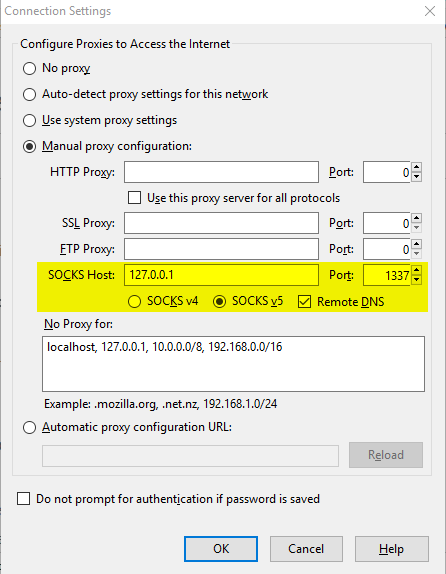How-To:Port Forwarding: Difference between revisions
No edit summary |
No edit summary |
||
| (3 intermediate revisions by the same user not shown) | |||
| Line 19: | Line 19: | ||
** Source port: (the port you want forwarded to the proxy - eg 1337) | ** Source port: (the port you want forwarded to the proxy - eg 1337) | ||
** Destination: <blank> | ** Destination: <blank> | ||
* Ensure Dynamic is selected as the type and then click Add | * Ensure Dynamic is selected as the type and '''then click Add''' | ||
[[Image: | [[Image:Proxy_putty.png|center|frame|How to configure PuTTY to be a SOCKS proxy]] | ||
* Click the Open button to connect, and enter your username/password. | * Click the Open button to connect, and enter your username/password. | ||
* Tell Firefox (or anything else) to use localhost 1337 as its HTTP proxy. You should now be browsing via RedBrick! | * Tell Firefox (or anything else) to use localhost 1337 as its HTTP proxy. You should now be browsing via RedBrick! | ||
[[Image:Http_proxy.png|center|frame|How to configure Firefox to use PuTTYs proxy]] | |||
'''OpenSSH for Windows''' | '''OpenSSH for Windows''' | ||
| Line 36: | Line 38: | ||
Where : | Where : | ||
* - | * -D specifies you want to link a dynamic port | ||
* 1337 is the local port (on your machine) you want to communicate on. | * 1337 is the local port (on your machine) you want to communicate on. | ||
* login.redbrick.dcu.ie is the server you want to open the SSH connection to | * login.redbrick.dcu.ie is the server you want to open the SSH connection to | ||
==Port forwarding for IRC== | ==Port forwarding for IRC== | ||
If you want to connect to RedBrick IRC with your own client you will need to use port forwarding to do this. | |||
The process is the same as the above, just using different addresses and port configurations. | The process is the same as the above, just using different addresses and port configurations. | ||
| Line 77: | Line 52: | ||
remote port: 6667 | remote port: 6667 | ||
So, | So for this it is instead using a local forward. So unlike the dynamic forward, instead set the option to be local, and add the destination as being irc.redbrick.dcu.ie:6667 | ||
On CLI this is: | |||
ssh -L 6667:irc.redbrick.dcu.ie:6667 username@login.redbrick.dcu.ie | |||
Now, just tell your | Now, just tell your IRC client that your IRC server is localhost :) | ||
[[Category:HowTo]] | [[Category:HowTo]] | ||
Latest revision as of 16:12, 30 September 2016
Why?
One example of why port forwarding is great is security. Downloading email and browsing the Internet in such a way that the immediate (local) network does not know what you are doing. All it sees is encrypted SSH traffic, like that used when you type on RedBrick normally.
The example being given is to use your Redbrick account to port forward data via Redbrick. You can then configure local applications to use the tunnel rather than the usual route over say insecure wireless or hotel wifi thereby hopefully securing your data in transit.
Theory
There are some good online guides and if you read this you should be able to deduce the basics of how SSH works with port forwarding.
How To do it
Windows
There are two ways of getting SSH to work on Windows.
PuTTY
PuTTY has built-in support for port forwarding.
- When you're connecting, after you've filled in the host name box (NOTE: If you wish to forward traffic through the RedBrick the host name must be login.redbrick.dcu.ie), click on Tunnels in the left-hand bar (second last item from the bottom).
- In the Port forwarding box, fill in the following values:
- Source port: (the port you want forwarded to the proxy - eg 1337)
- Destination: <blank>
- Ensure Dynamic is selected as the type and then click Add
- Click the Open button to connect, and enter your username/password.
- Tell Firefox (or anything else) to use localhost 1337 as its HTTP proxy. You should now be browsing via RedBrick!
OpenSSH for Windows
You can download and install OpenSSH for Windows and then use the same command as you would for unix, if you don't want to use PuTTY.
Linux
If you read the neworder guide above you should have a good idea of how to build the SSH command for the forwarding, like so:
ssh -D 1337 username@login.redbrick.dcu.ie
Where :
- -D specifies you want to link a dynamic port
- 1337 is the local port (on your machine) you want to communicate on.
- login.redbrick.dcu.ie is the server you want to open the SSH connection to
Port forwarding for IRC
If you want to connect to RedBrick IRC with your own client you will need to use port forwarding to do this.
The process is the same as the above, just using different addresses and port configurations.
localport: 6667 remote address: irc.redbrick.dcu.ie remote port: 6667
So for this it is instead using a local forward. So unlike the dynamic forward, instead set the option to be local, and add the destination as being irc.redbrick.dcu.ie:6667
On CLI this is:
ssh -L 6667:irc.redbrick.dcu.ie:6667 username@login.redbrick.dcu.ie
Now, just tell your IRC client that your IRC server is localhost :)

